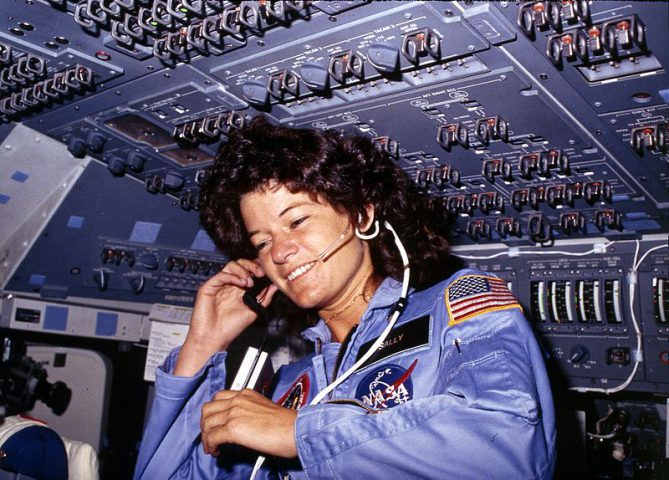When I was in high school contemplating who I wanted to be and what I wanted to do with my life, my mother used to say to me, “Remember, you can do anything you want.” It seemed strange at the time to hear it; of course I could do anything. I just needed to make up my mind and go. What I didn’t necessarily glean from her words was their underlying meaning. Later on, she would tell me that she was raised hearing that the only jobs really acceptable for women were teaching, nursing, being a secretary or being a mom. Whereas she wouldn’t have thought to do something other than what fit into those narrow categories, it never even occurred to me that there might be jobs I couldn’t (or shouldn’t) do just because I was a woman. And that way of thinking, the freedom to do what we want and be whom we want, is in no small part thanks to a woman named Sally Kristen Ride.
It was a one-two punch when Ride shot into orbit on June 18, 1983. Not only was she the first American woman to travel into space, at 32 years of age the Stanford University physicist was also NASA’s youngest astronaut ever, a record held to this day. She was picked out of a pool of more than 10,000 applicants, one of only 20 who were selected not for their air force or piloting qualifications, but as representatives of the scientific community — engineers, doctors and laboratory scientists charged with the task of bringing high science higher than it had ever gone before.
When she entered the program, she was one of six women training shuttle missions, but she eventually rose to the top of the class. Her bright personality and sharp wit were the traits people remember first. Her humor and good-natured esprit de corps were boons to her fellow space travelers, and her attitude toward exploration and cooperation rose above geopolitical convention. At an international Astronautical Federation conference, she was quietly invited to speak with a Russian cosmonaut — also a woman. The Americans had been advised against speaking with the Russians because Cold War tensions were still high, but the specialness of what they were doing was apparent to her, and she took the meeting.
When she finally left NASA, Sally Ride went on to become an educator and advocate for women in science. She understood the importance of getting kids involved in the STEM fields (science, technology, engineering and mathematics). She made it her personal mission to reach out to girls and young women, encouraging them to break the mold and do something extraordinary.
Despite her very public successes and fame, Sally Ride had a private side that surprised many when it came to light after she passed away of pancreatic cancer on July 23, 2012 at age 61. It wasn’t revealed until then that her lifelong friend and co-author of several science books for children, Tam O’Shaughnessy, was also her partner of 27 years.
While the announcement came as no surprise to those who knew her, it spun the heads of those who did not. Her personal life was no secret, but it also wasn’t something she ever wanted available to the public. Her contributions to science and her message to girls and young women were huge, and she will always be seen as one of our greatest female role models. But she avoided revealing that she was gay, thereby choosing not to be a role model for a population struggling with prejudice and discrimination.
It is tricky to address this issue. When she was working for NASA, a revelation of that nature could have affected her security clearance and ended her now famed career before it even began. But in recent years, when more and more people in the public eye were making the choice to come out and be a face for the gay community — almost to the point where the big reveal has become hardly a reveal at all — she stayed quiet. She could have shown the American people that gay people make important contributions, or, conversely, that important contributions are made by all kinds of people, and that discrimination based on something like sexual or emotional orientation could deprive the world of their many glowing achievements.
But there is also something to be said for privacy, and perhaps Ride wanted to be thought about in terms of her work, the content of her character, and the advances she has made to science and society rather than with whom she chose to spend her quieter moments.
Public disclosure undoubtedly helps many people still struggling with their identities, but privacy is becoming an increasingly rare and valuable commodity, so it’s understandable that she might have wanted to protect what little she had. The following comment by Facebook user Mark Horowitz on the Sally Ride Science page sums the issue up succinctly:
“Isn’t it unfortunate that Dr. Ride felt compelled, for whatever reasons, to keep ‘private’ her 27-year relationship with her female partner, and it was only announced posthumously? How far we have come, how much further we must travel.”
Throughout her life, Sally Ride remained true to her family, her vision, and herself — something many of us still find difficult to do. She was a pioneer and a patriot. Her influence helped underline the necessity of education and the importance of encouraging girls to reach for the stars and become the leaders of tomorrow. We should all endeavor to live lives full of meaning, and leave behind a legacy as uplifting.


What Do You Think?